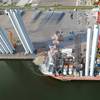The U.S. Navy has awarded Lockheed Martin a $10.6 million contract modification to integrate a sensor array capable of three-dimensional (3D) obstacle detection and classification, VHF communication and 3D bathymetry into the Navy's Advanced Development Unmanned Undersea Vehicle (ADUUV).
Under the contract modification, Lockheed Martin will provide engineering and manufacturing services to integrate the Littoral Precision Underwater Mapping Array (LPUMA) sensor into the ADUUV. LPUMA is produced by the Applied Research Laboratory in Austin, Texas. The first phase includes the design, fabrication and testing of a single ADUUV to support risk reduction for the Mission Reconfigurable UUV (MRUUV). Work will be performed in Riviera Beach, FL, and is expected to be completed by September 2007.
"The LPUMA sensor suite advances the revolutionary ADUUV's capabilities to the next level," said Jim Weitzel, Lockheed Martin Maritime Systems & Sensors vice president for Mission and Unmanned Systems. "By adding the next generation of precise 3D bathymetry and object detection and classification capabilities, the ADUUV can more rapidly change its mission from mine countermeasures to intelligence and surveillance, and expand to other missions as well."
The ADUUV, the first underwater vehicle of its kind designed to accommodate interchangeable modular payloads that can be swapped out for various missions, is the precursor to the revolutionary MRUUV. The system will be deployed from a Virginia-class or Los Angeles-class submarine for launch and recovery through submarine torpedo tubes and be used for clandestine intelligence collection, surveillance, and reconnaissance, as well as mine reconnaissance and tactical ocean survey.
Featured videos

Tracking Foreign Vessels Working in the U.S. Jones Act Market

Inside the Electrified Truckable Tug

Inmarsat Enhances Service to Drive Digitalization
Subscribe for
Maritime Reporter E-News
Maritime Reporter E-News is the maritime industry's largest circulation and most authoritative ENews Service, delivered to your Email five times per week









